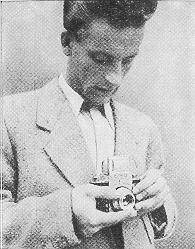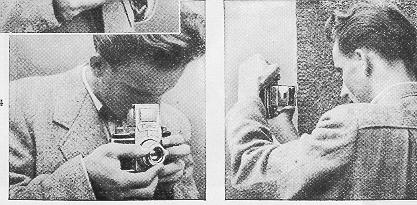EXA 24X35mm
IHAGEE CAMERA WORKS
Posted 7-18-'03
This camera manual library is for reference
and historical purposes, all rights reserved.
This page is copyright
© by

, M.
Butkus, NJ.
This page may not be sold or distributed without
the expressed permission of the producer
I have no connection with any camera company
On-line camera manual library
Back to main on-line manual page
If you find this manual useful,
how about a donation of
$3 to:
M. Butkus, 29 Lake Ave.,
High Bridge, NJ 08829-1701
and send your e-mail
address
so I can thank you.
Most other places would charge
you $7.50 for
a electronic copy
or $18.00 for a hard to read Xerox copy.
This will help me to continue to host this site,
buy new manuals, and pay their shipping costs.
It'll make you feel better, won't it ?
If you use Pay Pal, use the link below.
Use the above address for a check, M.O. or cash.
CLICK HERE TO CONTINUE TO English PDF
FILE MADE FROM HTML PAGE
CLICK HERE FOR PDF SCANNED
DIRECTLY FROM MANUAL - ENGLISH
EXA Mode d'emploi
CLICK HERE TO CONTINUE
EXA 24x35
TO WORD DOCUMENT
|
 |
|



|
1 = camera back catch
2 = film chamber for feeder cartridge (unexposed film)
D = cassette guide with film roller
3 =film chamber for take-up spool or take-up cartridge
4 = film transport knob
5 = take-up spool for exposed film
6 = film rewinding knob
7 = pivot of film rewinding knob No. 6
8 = image frame
9 = film guide
10 = film transport sprockets
l I = hinged camera bade
13 = film pressure plate
14 = shutter speed lever
15 = exposure counter
16 = rewind button (Push button before rewinding film!)
17 = reversing lever
18 = reflex finder-hood |
19 --: back wall of finder-hood with frame-finder rear sight
20 = protecting cover for hinged focusing magnifier
21 = button for folding magnifier up and down
22 = finder-hood catch
23 --- lens
24 = lens bayonet catch
25 = distance ring
26 = stop ring
27 = shutter release knob
27a= movable release lock
28 = milled knob for interchange of finder-hood and Special Prism
29 = contact nipple "F" regular flash
30 = contact nipple "X" electronic and regular flash
31 = red mark on camera
32 = red mark on lens
33 = Special Prism (delivered as accessory
35 = Loops for carrying
|
There may be slight deviations between the camera models and the illustrations in this booklet
The 35 mm EXA
is yours now and we wish you good luck with it. The camera will
give you much pleasure, for it is handy, easy to operate, and ready for use at a
moment's notice. So it is well suited to be your constant companion.
We would advise you, however, to read this instruction booklet
attentively before setting out to make photographs with your new camera. Having
acquired sufficient experience in correctly manipulating all parts that
eventually lead to taking pictures, you will obtain better results in every case
and avoid damaging the camera mechanism.
You are, no doubt, well aware of the unique advantages of the EXA
which is a single-lens reflex camera. In its interior there is a small mirror
which reflects the image taken by the lens on to the ground-glass focusing
screen. For that reason the future picture is always strictly the same as the
reflex image. This image permits critical focusing and composition of the
picture on the ground-glass screen to an unexcelled degree of precision.
We hope and wish you will obtain excellent results with the EXA and
are at your disposal for all questions concerning your camera.
Before loading the camera
it is advisable to get thoroughly acquainted with the camera
without film. To begin with, one should train oneself to master all the
movements: to release the shutter, to open and shut the camera, to use the
finder-hood, to compose and focus the picture, always handling the camera as
though it where loaded with film. It is only when a complete
mastery of the camera has been achieved that it should be loaded with film. To
start with, the use of an old exposed film is recommended.
A. How to open and shut the camera back
 |
Press camera back catch (1) to the Left (111. 3), and open
hinged back (11) completely. When closing the camera, care must be taken
that the camera back engages correctly in the groove on the body of the
camera. Press back (11) lightly towards camera body until the catch (1)
snaps into position.
|
B. How to open and shut the finder-hood
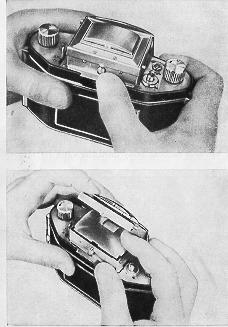 |
When the catch (22) is pressed inward, the finder-hood
automatically opens into working position llll. 4). A detailed description
of the various possibilities which it offers for composition and observation
of the image, will be found in section E of this booklet. For the present
let us stress the most important feet only: The ground-glass image is always
strictly the same as the future photograph. That is the reason why the
ground-glass image is the decisive factor for all operations which lead to
taking a picture: composition, choice of frame, critical focusing, stopping
down. The degree of brightness of the ground-glass image even permits of
determining the exposure time fairly accurately. - If there is no image
visible in the finder-hood, wind the film transport knob 14) once in the
direction of the arrow as far as it will go.
Before shutting the finder-hood make sure that the focusing magnifier is
in its neutral (vertical) position (Section E). Then, beginning at either
side, fold down the side walls, the back wall (19), and finally the front
part until it snaps into position (111. 5b) |
C. Shutter and film transport
 |
The EXA camera possesses a very simple and sturdy shutter.
In order to observe how it works, open the back of the unloaded camera or
remove the lens (see Section D). With the release of the shutter for
exposure the mirror swings upwards into a position parallel with the
focusing screen so that no stray light can get into the camera.
Therefore no image is visible when a picture has been taken and the shutter
has not been wound up again. The shutter speeds are set by means of the
lever (14), it does not matter, weather this is done before or after winding
up the shutter. The mark on the lever must come to lie against the mark of
the speed required (Ill. 6). 6). The figures engraved on the camera top
plate indicate fractions of seconds, so that e. g. 25 stands for l/25 sec.
Release by pressing the shutter release knob (27) gently (111.7). A cable
release can be screwed into the release button screw thread. The movable
release lock (27a) acts as a guard against unintentional tripping of the
shutter (important for storing and carrying the camera). The locking
lever has to be swung up in order to disengage the release knob. If the
speed-setting lever (14) is set to "B", the shutter will open upon pressure
on the release knob (27) and remain so as long as the knob (27) is pressed. |
It will close as soon as the pressure ceases. For "T" setting (after
pressure on the release knob (27) the shutter will remain open, until a second
pressure will close it again) a special cable release is available. Long
exposure times can be easily measured by counting the seconds or checked by a
watch. In this case it is absolutely necessary to use a tripod (tripod bush in
camera base) or to place the camera on a stable support (a table, a wall, etc.).
Handheld instantaneous exposures, however, are unconditionally possible. After
exposure wind the film transport knob (4) in the direction of the arrow` as far
as it will go. With this action the shutter is wound up, the film advanced one
frame, the mirror swung into focusing position (the reflex image is visible
again), and the exposure counter (15) advanced one mark.
Film advance and shutter winder being coupled, double exposure of one section of film is impossible.
D. How to focus the EXA
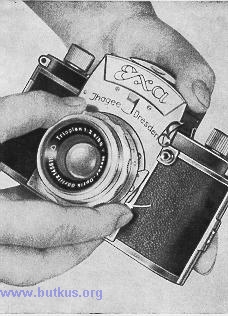 |
The lens (23) of the EXA is interchangeable, but the camera
should always be kept with the lens or it will be spoilt by dust. The front
element of the lens should be protected by a lens cover which must be taken
off before making an exposure. To remove the lens press the lens catch (24)
lightly towards the lens (Ill. 8) 8) and, holding the lens by the back ring,
turn it to the left, until the red mark on the camera (31) comes to lie
opposite the red dot on the lens (32), and the lens can be
lifted from the camera body. To insert a lens this procedure is reversed:
Insert lens (23) into the bayonet mount so that the red mark on the lens
(31) comes to lie against the red mark on the camera body (32). Now the lens
is turned to the right until it is heard to slip into the catch (24) on the
camera.
|
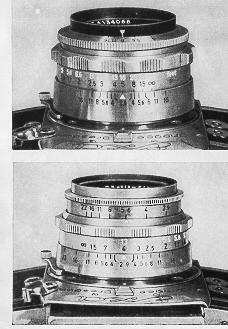 |
The best way to arrive at critical sharpness is to turn the
distance ring (25) to and fro until the main subject appears absolutely
sharp on the focusing screen in the finder hood. The figure on the distance
ring (25) that comes to lie opposite the red mark, indicates to which
distance the lens is set (lens-to-subject distance) (111. 9-11).The
diaphragm is adjusted by turning the knurled stop ring (26) until the stop
required is opposite the red mark. The figures on the ring indicate the
effective lens opening, i. e
low figures (2.9, 4, etc.) = large aperture = short exposure time
high figures (22, 16, etc.) = small aperture = long exposure time |
When increasing (or decreasing) the lens aperture, (or longer) exposure time
is required, namely for one stop double (or half) the normal exposure time; e.
g. if the normal exposure is 1/50 sec. for an aperture of f/8, it will be 1/25
sec. for f/11 or 1/100 sec. for f/5.6. A reduction of lens aperture (higher
figures) produces an increase in depth of field, that is to say, also points
some distance in front of and behind the main subject focused at appear to be
sharp. For further details see the following table. For instance: lens set at 5
m, stop 8: extent of depth of field from 3.02 m to 15.08 m, but lens set at 5 m,
stop 4: extent of depth of field from 3.76 m to 7.47 m.
The lenses of the EXA have the distance ring (25) behind the front stop ring
(26)(111.9-11). The depth of field scale engraved in the back ring of the lens
mount tells practically the same as the table.
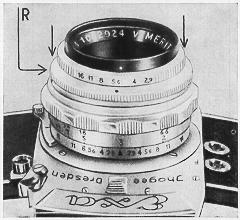 |
The aperture figures diverge from either side of the red
index mark. The index lines on the left hand side indicate the distance
in meters from which sufficient sharpness can be expected, those on the
right hand side the distance in meters up to which sharpness can be expected
(= range of depth of field). The respective distances are opposite the
figures of the aperture chosen. If the aperture figure on the right hand
side comes to lie to the right of the infinity sign (00) sharpness will
extend to infinity. Taking Illustration 9 as an example: lens set at 5 m.,
stop 8: range of sharpness form about 3 m to nearly 15m.
|
EXA Depth of Field
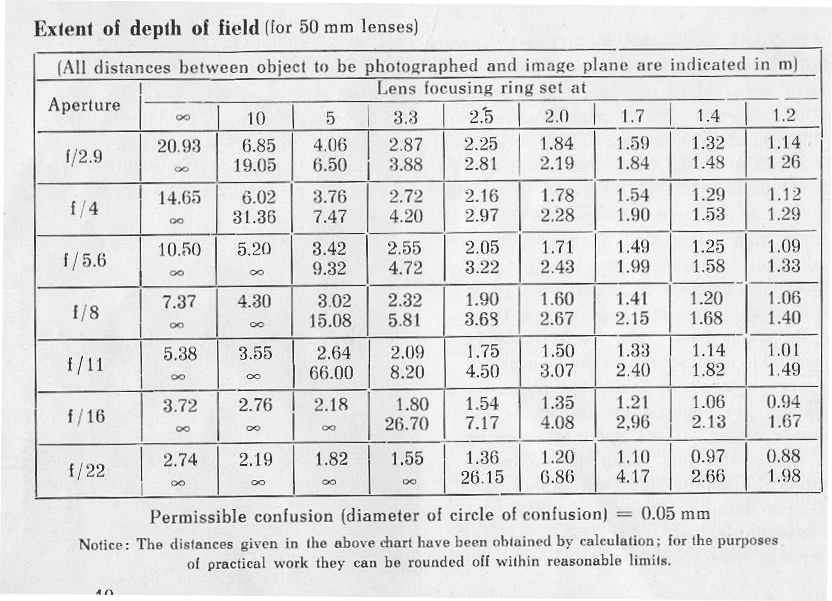
The Meritar (111.11) lens for the EXA has recently become available with pre-set
iris diaphragm as an optional extra. These lenses may be recognized by the ad
adjustable stop ring R. Having decided the aperture to use for your picture,
press back the knurled stop ring towards the camera body. Now turn the normal
iris ring until the required stop number is set against the red mark and release
the stop ring which will spring back to its original position.
For critical focusing use the lens at full aperture and immediately before
releasing the shutter turn the diaphragm ring up to the stop, an operation which
is carried out by "feel" alone and without the necessity to move the camera from
the sighting position.
E. How to use and exchange the finder-hood and Special Prism
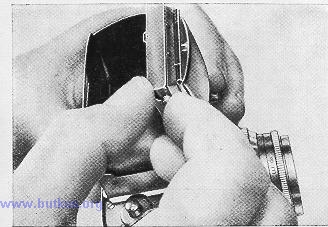 |
A bright ground-glass image is visible in the EXA
finder-hood. It is magnified by the ground glass (a piano-convex lens) to
such a degree that accurate focusing is possible. For more critical focusing
the built in magnifier is employed: To bring it into position move the
button (21) upward along the guide in the finder-hood front wall (111.12)
while holding the index finger along top of finder-hood front wall. To bring
the magnifier back to its neutral (vertical) position move button (21)
downwards again. |
The sharp outline of the ground-glass image facilities composition and determination of picture
frame. While turning the stop ring (26) the varying extent of depth of field can
be observed. Focusing should always be done at full aperture and the lens stopped down afterwards.
Normally the camera is held at chest level (111.13). Illustration 14 shows how to hold it when the magnifier is used.
When using the finder-hood vertical pictures can be taken at right angles to the object to be photographed, so that
the photographer can work without being hindered or observed (111.15).
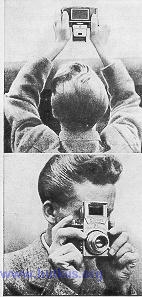 |
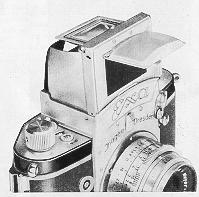 |
The Special Prism (see Section F) permits vertical pictures
in direct vision and shows an upright and laterally correct image. Control
of the ground-glass image is also possible when turning the camera upside
down and looking up into the finder-hood (111.16), as it is necessary when
shooting from behind a wall, over a crowd, etc. In order to use the
finder-hood (18) as a frame-finder (111. 18), bring magnifier into working
position by moving button (21) upwards and swing protective cover (20)
forward. The rectangular opening in the finder-hood back wall (19) serves as
frame-finder rear sight (111. 17). The use of the frame-finder is
particularly indicated for sports shots etc. |
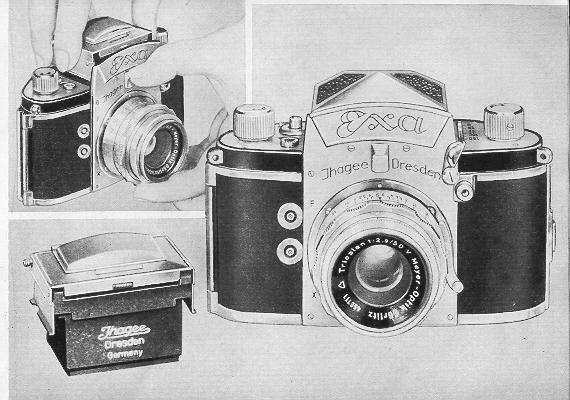
The EXA is a two-system camera: the finder-hood is interchangeable and can be
replaced by a Special Prism (111.19 and 20). This Special Prism (see also 111. 1
and 2) is delivered separately as a camera accessory and specially designed for
snapshots. The camera is raised to eye level position (111. 21) and the object
to be photographed is viewed in direct vision through the finder. The Special
Prism shows an upright and laterally correct reflex image which corresponds to
nature in all details for both vertical and horizontal pictures ([11. 22). The
image in the Special Prism moves in the same direction as the object. Holding
the camera at eye level it is easy to follow moving subjects.
Interchange of finder-hood
Close finder-hood (18). Push milled knob (28) downwards and lift closed
finder-hood (18) from camera body (111.19). When replacing the finder-hood
insert finder-hood carefully in perpendicular direction into the opening and
press it down until it snaps in audibly. The Special Prism (33) is inserted into
and removed from the camera in exactly the same way as the finder-hood (18).
Never use forcer
F. How to load the EXA
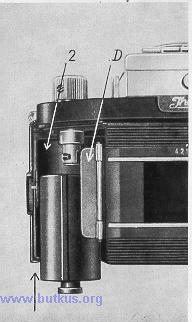 |
The EXA uses perforated miniature cine-film of 35 mm, width
for 36 exposures 1 1/2 x 1 in. (=24x36 mm.) on a strip of the usual length
of 1.60m. The film is supplied either in factory filled cartridges or an
empty cartridge is loaded with refill film or with bulk film. For further
details apply to your photo dealer. When using bulk film no special trimming
of the film end is necessary except rounding off the angles.
Open camera back (see Section A). The film chamber (2) of the EXA is
provided with a cassette guide (D) (see legend in margin of illustration).
The loaded film cartridge should therefore be inserted from beneath the
camera so that the mouth of the cartridge lies against the edge of the
guide. The film is then led over the rollers and sprockets to the
transport spool (10). Insert pivot (7) of rewinding knob (6) into hollow
part of cartridge so that the groove of the pivot (7) engages in the bar
of the center spool. The cartridge must not be larger than the chamber(2)
or else it will not be possible to shut the camera. |
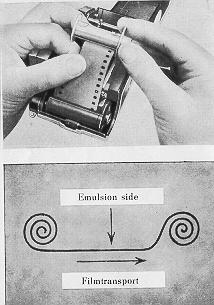 |
Make sure that the free end of the film runs straight into
the film track (9, film guide), the emulsion (mat) side of the film showing
towards the lens. Take care not to pull more than 10 cm. of film from the
cartridge. Remove take-up spool from film chamber (3) and push free end of
film under spring of take-up spool until film keeps fast (111.24) The film
is wound into the take-up spool with the emulsion side outwards (See Diagram
25). Insert take-up spool (5) again and make sure that the groove of the
pivot of the film transport knob (4) engages in the bar of the center spool.
The strip of film must run perfectly straight from film track to film
transport sprockets [ 10) and take-up spool (111. 26).
When closing camera back (11) make sure that cartridge, film, and spool
are kept in their proper positions. Now two "blind" exposures must be
made: Open finder-hood (18) as described in Section B. |
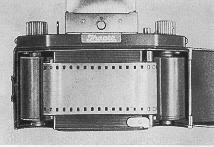 |
If there is no image visible in the finder-hood, wind film transport knob
(4) up to the stop in the direction of the arrow. Release by pressing
shutter release knob (27): first "blind" exposure. Wind knob (4) again up to
the stop and release again: second "blind" exposure. (webmaster: these are
the typical "blank" shots to move exposed film out of shutter area) Wind
film transport knob a third time as far as it will go: an unexposed piece of
film is brought into position in the image frame (8). |
Now set picture counter (15) by turning the milled knob with the right hand
forefinger in the direction of the (Ill. 27) until No. 1 points to the picture
counting mark, and the camera is ready for the first "real" exposure.
If one does not wish to rewind the exposed film after 36 exposures into the
cartridge, but to remove it from the camera in a second cartridge, the procedure
is strictly the same as described above. Simply remove take-up spool (5)
and replace it by a second cartridge. Spare cartridges are on sale for
this purpose, or used ones may be employed. In order to load the cartridge, open
it and fix film on its center spool. Place it into film chamber and make sure
that the pivot of the film transport knob (4) engages in the bar of the
center spool and that the film is wound up emulsion side outwards. Illustration
28 shows the path the film must take.
G. How to change films
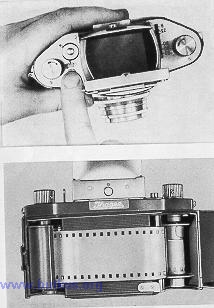 |
If the film is wound on the take-up spool belonging to the
camera, one length of film will take more than 36 exposures. Even if the
picture counter points to "36' already, one or two more exposures can be
made, until the film transport knob (4) cannot be wound any more. Now the
film must be rewound in the following manner: Holding the camera in your
left hand, press down the button (16) with the thumb, while the other hand
turns the rewinding knob (6) in the direction of the arrow (111. 29). As
long as the film is being rewound, the film transport knob (4) will rotate
in an anti-clockwise direction. Once the film is rewound into the cartridge,
the transport knob (4) will stop. Now open the camera (see Section A) and
remove the cartridge containing the exposed film. To make the camera ready
for loading and regular film transport again, make sure that the small
reversing lever (17) is pushed at once towards the camera back and springs
back again (111. 30) |
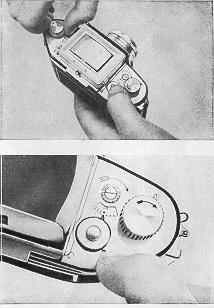 |
If, on the other hand, the film is wound into an empty
cartridge instead of into the take-up spool, only 36 exposures can be made.
As soon as the counter (15) points to "36", make two more "blind" exposures,
so that all 36 exposed frames will disappear into the cartridge. Open camera
back, take out feeder cartridge, open the latter and detach the film end
from the center spool. This done, remove the take-up cartridge and wind up
the rest of the film by turning the top of the center spool. |
H. Flashlight
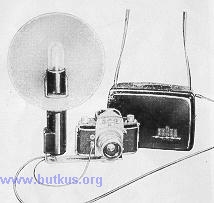 |
For flash exposures, the EXA has two synchronized contacts: the X-contact and the F-contact.
The X-contact is closed as soon as light falls on the entire picture gate.
The lower contact nipple (30) belongs to the X-contact. This is where the
contact plugs of flashtube equipment (111. 31) (electronic flash units) are
inserted. The shutter setting in connection with electronic flashes has to be
l/60 sec. The flash duration is equal to the burning period of the flash tube
which, as a rule, is 1/500 to l/6000 sec. This is sufficiently short to capture
the quickest movement. Literature on electronic flash units is available at the
special dealers or straight from the manufacturers. |
With the shutter set at "B" the X-contact also synchronizes all regular flash units according to the open flash method.
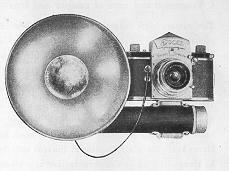 |
In this case, the Ihagee flash unit (111. 32), or. any other
flash equipment, has to be used with its connecting plug inserted into the
X-contact of the EXA (details are given in the Instruction Booklet for "The
Ihagee Flashgun").
The F-contact, closes 11 to 13 ms. sooner than the X-contact, which means,
a moment before the entire picture gate is illuminated. The upper contact
nipple (29) belongs to the F-contact and is designed to accept the contact
plug of the Ihagee Flashgun (111. 32) or of any other regular flash
equipment. |
The EXA F-contact permits employing such lamps as the small, moderately
priced F 19 of RET Elektroteeknik Eisenach, the Osram XM 1, and A XM 5 and the
Philips PF 1, and PF 5, (or American flash bulbs: Amplex No. 5, Dura Flash No.
5, General Electric Ph 5, Westinghouse No. 5), shutter speed: 1/25 sec.
The actual flash duration is equal to the burning period of the flash bulb and
may range from l/260 to l/l00 sec. For further particulars, please refer to the
slips enclosed with the flash bulbs.
I. Treatment and care of camera and lens
The camera with lens should always be kept in the ever ready case
or wrapped in a piece of cloth that will not ravel out. All easily accessible
parts should be kept clean and, if necessary, dusted with a soft brush. Above
all the film track with the film guide (9), the film chambers (2 and 3), the
camera back (11), the two springs (12), and the film pressure plate (13) should always be kept clean.
The reflex mirror of the EXA is surface-silvered and extremely liable to suffer
from careless handling. A very soft hair-brush should be used when cleaning it a
long intervals. The EXA must be carefully protected against dust, sand, etc. as
well as against moisture in any form. Never touch the glass surfaces of the lens
with the fingers 1 If necessary, the lens surfaces may be cleaned with a soft
chamois leather or a piece of soft linen that will not ravel out.
We would advise against tampering with the camera mechanism under any
circumstances Only expert mechanics being able to do repairs properly, our
advice to you is to have repairs done in our works whenever that is possible.
J. EXA accessories
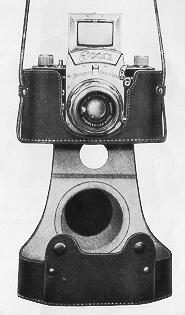 |
The EXA takes practically all EXAKTA accessories with the exception of the
ever ready case of the EXAKTA. Special lenses with focal lengths exceeding 100
mm. cannot be used unconditionally in the EXA (vignette).
The EXA Everready Case has been designed to protect the camera without
impairing its operative speed. All mechanical parts which are important for
picture taking, can be operated even if the camera is in the case. A camera
retaining screw with tripod socket secures the camera in the carrying case for
safety (111. 33).
|
Other accessories:
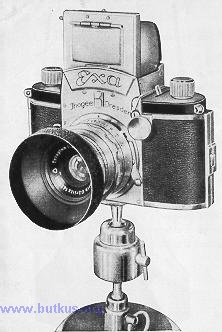 |
The Giant Release button (111. 34) is screwed into the
shutter release knob (27) whose effective surface it increases. It allows of
releasing the shutter with ease and security when wearing gloves or when the
fingers are numb with cold.. Color Filters. The purpose of filters in
black-and-white photography is to render the colors of the object to be
photographed in the grey tone values that correspond to the impression received
by the human eye, as the film registers several colors otherwise than the human
eye. All filters are corrective filters: they lighten objects of their own
color, while darkening those of their complementary color; e. g. a yellow filter
ill produce tones of a lighter gray for the yellow areas, and darker gray tones
for the blue areas of the object, for, to the human eye, yellow appears to be
the lightest, and blue the darkest color. Consequently, the blue sky will appear
darker in the picture and the white clouds will offer a good contrast. The
results obtained when using filters, further depend upon the light conditions
and the color sensitivity of the film used. For more detailed information
consult the technical literature. |
The filters are pushed on to the lens
front mount. The filter mounts will take, if required, a lens hood or a
soft-focus disc. As the color filters cut out certain parts of the light, an
increase in exposure time is necessary when using them:
Yellow filters, light and medium 2-3 times the normal exposure time
Green filters, light 3 times the normal exposure time
Blue filters, light 3 times the normal exposure time
Red filters, light 8 times the normal exposure time
The Lens Hood [III. 34) is far more important than is
generally believed. It protects the lens not only against frontal stray light
when photographing against the sun, but in every case against side stray light
and glares, enhancing thereby the contrasts in the picture. The lens hood is
pushed on to the lens front mount or the front ring of the filter mount.
Soft - Focus Discs are widely used to catch
'atmosphere". Causing the bright areas to appear slightly over-emphasized
towards the darker areas it is their purpose to register sunny atmosphere in a
picture. The soft-focus discs are also pushed on to the lens front mount.












